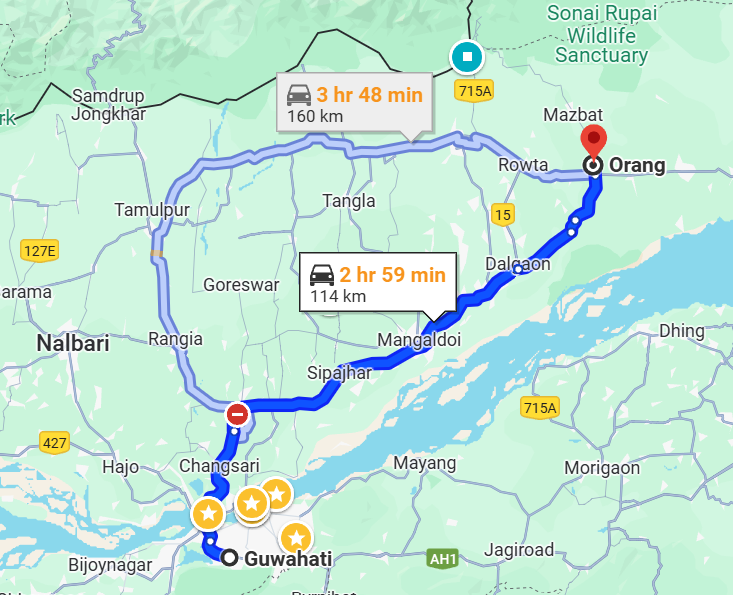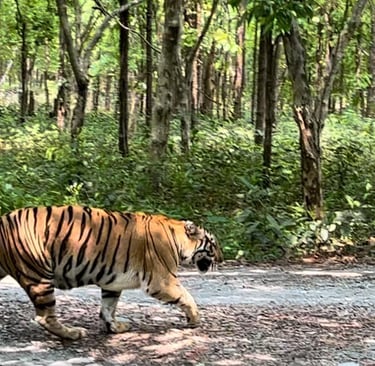Food is to the body as Travel is to the soul. And Blogging is the glues that binds them all
Orang Tiger Reserve Tragedy: Maneater on the prowl?
It’s been more than a fortnight since a Tiger killed a Forest Guard at Orang National Park. Mr Dhanmani Deka, a seasoned professional who had withered many springs in the wilderness, was attacked while patrolling the Bilapar Forest Camp. His tragic death perhaps indicates that it is now time for Forest Department reforms
WILDLIFE
The Thinking Me
9/14/20244 min read


It’s been more than a fortnight since a Tiger killed a Forest Guard at Orang National Park. Mr Dhanmani Deka, a seasoned professional who had withered many springs in the wilderness, was attacked while patrolling the Bilapar Forest Camp.
Mr. Deka had years of experience walking the jungles of Assam. It is believed that he was an expert in his job as well. However, the very forests he had protected all his life ended up turning on him.
The 32-year-old was apparently attacked from behind by the Tiger and had little time to respond. His outdated .303 rifle dropped from his hands and the beast carried him away. The Mahout who was accompanying him reportedly picked up the gun and fired shots, but by then the Tiger had escaped with its prey.
Orang Tiger Reserve
I have been to Orang National Park on two separate occasions. This isolated forest is one of the smallest in the country, covering an area of just 79.28 square km. Initially established as a Wildlife Sanctuary, Orang was elevated to the status of National Park in 1999. It is apparently the smallest Tiger Reserve in the country based on core area.
While it is closed at the moment, this park sees significant footfall during the season, which is from November to May. Due to its small area, the park also boasts one of the highest tiger densities in India. However, Tiger sightings are reportedly rare.
Only 115 km away from Guwahati, Orang is easily accessible by road. Apart from the Royal Bengal Tiger, the place is also well known for Rhinoceros, Elephants, Wild Boars and Hog Deers. The Pygmy Hog, a critically endangered species, has been reintroduced in this park.
India’s rising Tiger population
According to the Tiger Census carried out by National Tiger Conservation Authority (NTCA) in 2022, there are 3682 Tigers in the wild in India. Of these, 227 are in Assam, including 104 in Kaziranga National Park and 26 in Orang.
According to a report published by the Union Environment Ministry last year, 35% of the 53 tiger reserves in India require immediate action, including improved protection measures, habitat restoration, tiger reintroduction and ungulate augmentation.
It is unclear whether Orang falls among those, but it is evident that the park has issues which need to be addressed.
The park has been witness to man-animal conflict since its inception, with illegal encroachment and ramphant poaching threatening its existence at one point of time. Things have looked better of late, but this recent incident will be a huge setback to the park.
When a Tiger sets sights on man
There are a few reasons why Tigers become man eaters . The legendary Tiger conservationist Jim Corbett did some extensive work hunting down man eaters and we owe a lot to our understanding of these beasts due to his efforts.
It is believed that Tigers turn to humans due to old age or injury, lack of natural prey, proximity to man or abnormal behaviour. While not entirely impossible, it is very hard to reverse a man eater to a natural hunter, so the most common practice is to put the beast to rest.
It is unclear whether the tiger in question at Orang National Park was a man eater. It could also be a mother being protective of her offspring, or an aggressive male defending his territory. Whatever the reason, necessary steps have to be taken immediately to capture the beast and ensure that it causes no further damage.
Forest Department crying out for reforms?
Dhanmani Deka was ultimately discovered around 3 kms away from the site where he was attack. He had been mauled to death, there were bite marks all across his body. One can only imagine the trauma he went though in the final stages of his life.
The heartbreaking incident does raise a lot of questions. Why wasn’t Mr. Deka alerted about the presence of a tiger in the vicinity? Why was such a small team deployed to travel through a supposedly dense region in the forest? Why wasn’t such an attack anticipated in the forest with one of the highest densities of tigers in India?
Dhanmani Deka was an asset not just to the Forest Department, but also to the animals he had helped protect. It is an irony that he had to give his life to the creatures he was guarding. He would have had so many tales to share, but they will now remain untold.
Mr. Deka was only 32 when he laid his life in the service of the forest. His untimely demise should be a wake-up call for the forest department, who must introduce state-of-the-art technologies, like drones, to aid in their daily functioning. The entire patrolling process should be revamped to ensure that the people who spend their lives in the jungle do not fall prey to the wild.





